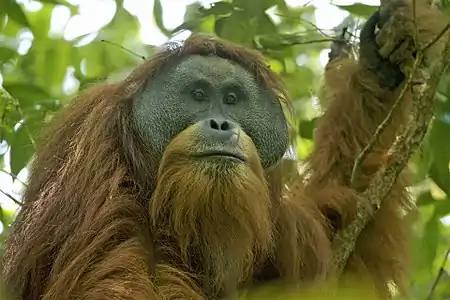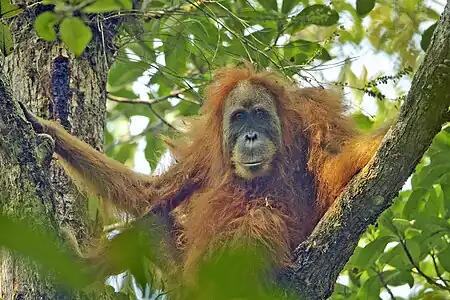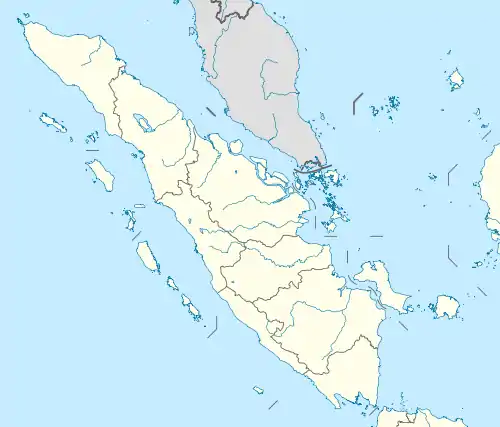Tapanuli orangutan
The Tapanuli orangutan (Pongo tapanuliensis) is a species of orangutan restricted to South Tapanuli in the island of Sumatra in Indonesia.[3] It is one of three known species of orangutan, alongside the Sumatran orangutan (P. abelii), found farther northwest on the island, and the Bornean orangutan (P. pygmaeus). It was described as a distinct species in 2017.[4] As of 2018, there are roughly 800 individuals of this species and it is currently on the critically endangered species list.[5]
| Tapanuli orangutan | |
|---|---|
 | |
| Adult male | |
 | |
| Adult female Both near Lake Toba | |
| Scientific classification | |
| Domain: | Eukaryota |
| Kingdom: | Animalia |
| Phylum: | Chordata |
| Class: | Mammalia |
| Order: | Primates |
| Suborder: | Haplorhini |
| Infraorder: | Simiiformes |
| Family: | Hominidae |
| Genus: | Pongo |
| Species: | P. tapanuliensis |
| Binomial name | |
| Pongo tapanuliensis Nurcahyo, Meijaard, Nowak, Fredriksson & Groves, 2017[note 1] | |
 | |
| Approximate location in Sumatra | |
Taxonomy
Discovery and naming
An isolated population of orangutans in the Batang Toru area of South Tapanuli was reported in 1939.[6] The population was rediscovered by an expedition to the area in 1997,[7] but it was not recognized as a distinct species then.[8] Pongo tapanuliensis was identified as a distinct species, following a detailed phylogenetic study in 2017. The study analyzed the genetic samples of 37 wild orangutans from populations across Sumatra and Borneo and conducted a morphological analysis of the skeletons of 34 adult males.[3] The holotype of the species is the complete skeleton of an adult male from Batang Toru who died after being wounded by locals in November 2013.[3][9] The holotype is stored in the Zoological Museum of Bogor.[3] The skull and teeth of the Batang Toru male differ significantly from those of the other two orangutan species.[3][10] Comparisons of the genomes of all 37 orangutans using principal component analysis and population genetic models also indicated that the Batang Toru population is a separate species.[3]
The specific name, tapanuliensis, as well as the common name, Tapanuli orangutan, refer to Tapanuli, the hilly region in North Sumatra where the species lives.[3][11]
Phylogeny
Genetic comparisons show that Tapanuli orangutans diverged from Sumatran orangutans about 3.4 million years ago, and became more isolated after the Lake Toba eruption that occurred about 75,000 years ago.[3][4][9] They had continued sporadic contact that stopped between 10,000 and 20,000 years ago. Tapanuli orangutans diverged from Bornean orangutans about 674,000 years ago.[10] Orangutans were able to travel from Sumatra to Borneo because the islands were connected by land bridges as parts of Sundaland during recent glacial periods when sea levels were much lower.[9] The present range of Tapanuli orangutans is thought to be close to the area where ancestral orangutans first entered what is now Indonesia from mainland Asia.[3]
Description
.jpg.webp)
Tapanuli orangutans resemble Sumatran orangutans more than Bornean orangutans in body build and fur color.[3] However, they have frizzier hair, smaller heads, and flatter and wide faces.[4] Dominant male Tapanuli orangutans have prominent moustaches and large flat cheek pads, known as flanges, covered in downy hair. The Tapanuli orangutan differs from the other two existing orangutan species in several specific features:
- their upper canines are larger;
- they have a shallower face depth;
- their pharyngotympanic tube is shorter;
- they have a shorter mandibular joint;
- they have a narrower maxillary incisor row;
- the distance across the palate at the first molars are narrower;
- there is a smaller horizontal length between the mandibular symphysis;
- they have a smaller inferior torus; and
- the width of the ascending ramus located in the mandible.
As with other two orangutan species, males are larger than females; males are 137 cm (54 in) in height and 70–90 kg (150–200 lb) in weight, females are 110 cm (43 in) in height and 40–50 kg (88–110 lb) in weight.[12] When comparing the Tapanuli orangutan with the Pongo abelii, the Tapanuli orangutan has a deeper suborbital fossa, a triangular pyriform aperture, and a facial profile that is more angled.[3]
Behavior
The loud, long-distance call or 'long call' of male Tapanuli orangutans has a higher maximum frequency than that of Sumatran orangutans, and lasts much longer and has more pulses than that of Bornean orangutans.[3][9] Their diet is also unique, containing unusual items like caterpillars and conifer cones.[10] Tapanuli orangutans are thought to be exclusively arboreal as scientists have not seen them descend to the ground in over 3,000 hours of observation. This is probably due to the presence of Sumatran tigers in the area.[13] Their other main predators are clouded leopards, Sumatran dholes and crocodiles.[14] Tapanuli orangutans have slow reproductive rates causing a problem in increasing population.[15]
Habitat and distribution
Tapanuli orangutans live in tropical and subtropical moist broadleaf forests located south of Lake Toba in Sumatra. The entirety of the species is found in an area of about 1,000 km2 (390 sq mi) at elevations from 300 to 1,300 m (980 to 4,300 ft).[3] Tapanuli orangutans are separated from the island's other species of orangutan, the Sumatran orangutan, by just 100 km (62 mi).[11]
Conservation
With fewer than 800 individuals restricted to an area of about 1,000 km2 (390 sq mi), the Tapanuli orangutan is the rarest great ape.[3] It is listed as critically endangered by the International Union for Conservation of Nature (IUCN) because of hunting, conflict with humans, the illegal wildlife trade, rampant habitat destruction for small scale agriculture, mining and a proposed hydroelectric dam, the Batang Toru hydropower project, in the area with the highest density of orangutans, which could impact up to 10% of its already dwindling habitat and degrade important wildlife corridors.[1][3][13] Conservationists predict an 83% decline in three generations (75 years) if the necessary conservation measures and practices are not implemented.[1] Inbreeding depression is likely due to the small population size and fragmented range. This is supported by the genomes of the two Tapanuli orangutan individuals, which show signs of inbreeding.[3] In August 2019 Swiss environmental group PanEco, which is a partner in the Sumatran Orangutan Conservation Programme, dropped its previous opposition to the dam, several months after firing several researchers who opposed the new strategy.[16]
Notes
References
- Nowak, M.G.; Rianti, P.; Wich, S.A.; Meijaard, E.; Fredriksson, G. (2017). "Pongo tapanuliensis". IUCN Red List of Threatened Species. 2017: e.T120588639A120588662. doi:10.2305/IUCN.UK.2017-3.RLTS.T120588639A120588662.en. Retrieved 19 November 2021.
- "Appendices | CITES". cites.org. Retrieved 2023-03-01.
- Nater, Alexander; Mattle-Greminger, Maja P.; Nurcahyo, Anton; Nowak, Matthew G.; de Manuel, Marc; Desai, Tariq; Groves, Colin; Pybus, Marc; Sonay, Tugce Bilgin; Roos, Christian; Lameira, Adriano R.; Wich, Serge A.; Askew, James; Davila-Ross, Marina; Fredriksson, Gabriella; de Valles, Guillem; Casals, Ferran; Prado-Martinez, Javier; Goossens, Benoit; Verschoor, Ernst J.; Warren, Kristin S.; Singleton, Ian; Marques, David A.; Pamungkas, Joko; Perwitasari-Farajallah, Dyah; Rianti, Puji; Tuuga, Augustine; Gut, Ivo G.; Gut, Marta; Orozco-terWengel, Pablo; van Schaik, Carel P.; Bertranpetit, Jaume; Anisimova, Maria; Scally, Aylwyn; Marques-Bonet, Tomas; Meijaard, Erik; Krützen, Michael (2 November 2017). "Morphometric, behavioral, and genomic evidence for a new orangutan species". Current Biology. 27 (22): 3487–3498. doi:10.1016/j.cub.2017.09.047. PMID 29103940.
- Reese, April (2 November 2017). "Newly discovered orangutan species is also the most endangered". Nature. 551 (7679): 151. Bibcode:2017Natur.551..151R. doi:10.1038/nature.2017.22934. PMID 29120449.
- Nasution, Arfah; Perwitasari-Farajallah, Dyah; Utami-Atmoko, Sri Suci (2018). "Declining orangutans population in the unprotected forest of Batang Toru". Tropical Life Sciences Research. 29 (2): 77–87. doi:10.21315/tlsr2018.29.2.6. PMC 6072730. PMID 30112142.
- Natuur in Zuid- en Oost- Borneo. Fauna, flora en natuurbescherming in de Zuider- en Ooster-Afdeeling van Borneo. In 3 Jaren Indisch Natuur Leven: Opstellen over Landschappen, Dieren en Planten, Tevens Elfde Verslag (1936-1938) [Nature in South and East Borneo. Fauna, flora and nature conservation in the southern and eastern part of Borneo. In 3 Years Dutch Indies Nature Life: Compilation on Landscapes, Animals and Plants, Eleven Reports (1936-1938)] (in Dutch). Batavia, Indonesia: Nederlandsch-Indische Vereeniging tot Natuurbescherming. 1939. pp. 334–411.
- Meijaard, Erik (25 December 2015). "A Sumatran wonderland". Jakarta Globe. Archived from the original on 10 August 2018. Retrieved 15 November 2017.
- Gill, Victoria (2 November 2017). "New great ape species identified". BBC News. Retrieved 3 November 2017.
- Goldman, Jason G. (2 November 2017). "New species of orangutan is rarest great ape on earth". National Geographic Society. Retrieved 6 November 2017.
- Stokstad, Erik (12 November 2017). "New great ape species found, sparking fears for its survival". Science. Retrieved 15 November 2017.
- Davis, Nicola (2 November 2017). "New species of orangutan discovered in Sumatra – and is already endangered". The Guardian. Retrieved 15 November 2017.
- "Tapanuli Orangutan". New England Primate Conservancy. Retrieved 2020-11-06.
- Leahy, Stephen (9 August 2018). "Hydroelectric Dam Threatens to Wipe Out World's Rarest Ape". National Geographic Society. Archived from the original on 10 August 2018.
- "Tapanuli Orangutan Facts, Pictures & Information For Kids & Adults". Active Wild. Retrieved 2020-11-06.
- Wich, Serge A.; Fredriksson, Gabriella; Usher, Graham; Kühl, Hjalmar S.; Nowak, Matthew G. (2019). "The Tapanuli orangutan: Status, threats, and steps for improved conservation". Conservation Science and Practice. 1 (6): e33. doi:10.1111/csp2.33. hdl:21.11116/0000-0004-0336-C. S2CID 155174152.
- Rochmyaningsih, D. (2019). "Accusations fly over threat to rarest great ape". Science. 365 (6458): 1064–1065. Bibcode:2019Sci...365.1064R. doi:10.1126/science.365.6458.1064. PMID 31515361. S2CID 202568749.
External links
 Media related to Pongo tapanuliensis at Wikimedia Commons
Media related to Pongo tapanuliensis at Wikimedia Commons
